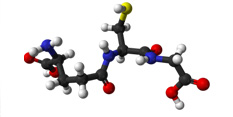







Glutathione molecule
Glutathione is a ubiquitous compound found in our bodies. Aside from its many ascribed biologic functions, it has also been implicated in skin lightening. Glutathione induced inhibition of tyrosinase glycosylation, blocks the maturation and transfer of tyrosinase from GERL (Golgi-endoplasmic reticulum-lysosome)-coated vesicles to the pre-melanosome. Other mechanisms of action proposed for glutathione include :
- Direct inactivation of the enzyme tyrosinase by binding and chelating copper within the enzyme’s active site
- Mediating the switch mechanism from eumelanogenesis to phaeomelanogenesis, as glutathione participates in the conversion of dopaquinone to pheomelanin. The observed differences in the glutathione and glutathione-related enzyme content between black and yellow (or red) skin provide evidence that the increase of glutathione-reductase activity in the environment of the melanocytes may stimulate the pigment cells to produce phaeomelanin instead of eumelanin pigment. As expected, the lowest levels of reduced glutathione (GSH) were found associated with eumelanin type pigmentation, whereas the highest ones were found in the skin with phaeomelanin producing melanocytes;
- Quenching of free radicals and peroxides that contribute to tyrosinase activation and melanin formation;
- Modulation of depigmenting abilities of melanocytotoxic agents.
- Research results also indicate that glutathione inhibits the synthesis and agglutination of melanin by interrupting the function of L-DOPA. The balance between CysH and GSH, which is partly determined by the rate of utilization of CysH for GSH biosynthesis, regulates not only the levels of 5-S-CD and DOPA but also the melanogenic activity of pigment cells. Since DOPA functions as a cofactor in the monophenolase reaction of tyrosinase, it is proposed that the ratio of 5-S-CD to DOPA may be an important factor in the regulation of tyrosinase activity in situ.
These concepts supported by the various experimental evidence presented form basis for future research in the use of glutathione in the treatment of pigmentary disorders.
Related Products:
SW+SS Skin Whitening - Exfoliating Bar Soap With Glutathione
>
>
>
>
>
>
>
>
>
>
>
>
>
>
>
>
>
>
>
>
>
>
>
>
>
>
>
>
>
>
>
>
>
>
>
>
>
>
>
>
>
>
>
>
>
>
>
>
>
>
>
TOP 20
Hydroquinone
Monobenzyl Ether of Hydroquinone
Azelaic Acid
Kojic Acid
Arbutin
Retinoids
Mequinol
Niacinamide
Soy
Vitamin C
Corticosteroids
Licorice
Hydroxystilbene
Aloesin
Glutathione
Glycolic Acid
N Acetyl Glucosamine
Gentisic Acid
Green Tea
Melatonin
SKIN WHITENING AGENTS A-Z
a-Hydroxyacids
Aloesin
Alpha Tocopherol and Alpha Tocopherol Ferulate
Arbutin
Azelaic Acid
Centaureidin and Methylophiopogonanone B
Gallic Acid and Derivatives
Gingko
Ginseng
Glutathione
Glycolic Acid
Green Tea
Hesperidin
Hydroquinone
Hydroxycinnamic Acid and Derivatives
Hydroxystilbene
Kojic Acid
Licorice
Linoleic Acid
Magnesium Ascorbyl Phosphate
Melatonin
Mequinol
Monobenzyl Ether of Hydroquinone
Mulberry
N Acetyl Glucosamine
N-Acetyl-4-S-Cysteminylphenol
Niacinamide
Retinoids
Salicylic Acid
Soy
Vitamin C

<< Previous: Aloesin
Next: Glycolic Acid >>